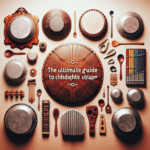<!DOCTYPE html>
<html lang="en">
<head>
<meta charset="UTF-8">
<meta name="viewport" content="width=device-width, initial-scale=1.0">
<title>Unlocking the Mysteries of Handpan Harmonics: A Comprehensive Guide</title>
</head>
<body>
<article>
<section>
<p>Handpans are relatively new on the global music scene compared to other percussion instruments, but they have quickly captured the hearts of musicians and non-musicians alike. One of the most captivating aspects of handpans is their rich harmonics, which can transform a simple note into a complex, resonant soundscape. This comprehensive guide aims to unlock the mysteries of handpan harmonics and provide insights into how you can maximize the potential of this mesmerizing instrument.</p>
</section>
<section>
<h2>Understanding the Basics</h2>
<p>Handpans, often resembling upside-down steel bowls, consist of a central note, known as the "Ding," surrounded by a series of tuned notes on a resonant steel shell. The unique arrangement and tuning of these notes give handpans their distinctive sound. However, the true magic of a handpan lies in its harmonics—vibrations that occur at multiples of the fundamental frequency of each note.</p>
<p>When you strike a note on a handpan, you are not just hearing a single pitch. Instead, you are hearing a complex combination of the fundamental frequency and its accompanying harmonics. These harmonics are responsible for the instrument's ethereal and meditative sound quality.</p>
</section>
<section>
<h2>The Science of Harmonics</h2>
<p>Harmonics, also known as overtones, are higher frequencies that resonate above the fundamental note when it is played. Each harmonic corresponds to an integer multiple of the fundamental frequency. For example, if a note has a fundamental frequency of 200 Hz, its first harmonic would be at 400 Hz, the second harmonic at 600 Hz, and so on.</p>
<p>In a handpan, the layout and shape of the notes are meticulously crafted to enhance these harmonics. This is why handpans are often described as having a "voice" rather than just a sound. Each note on a well-tuned handpan sings with a chorus of harmonics that add depth and richness to the music.</p>
</section>
<section>
<h2>Playing Techniques for Enhanced Harmonics</h2>
<p>Your playing technique greatly influences the resonance and clarity of the harmonics produced by a handpan. Here are some tips to help you bring out the best harmonics in your playing:</p>
<ul>
<li><strong>Strike Location:</strong> The position where you strike a note can greatly impact the harmonics. Experiment with striking the center, edge, and different parts of the note to find the sweet spot that yields the richest harmonics.</li>
<li><strong>Hand Position:</strong> The shape and rigidity of your hand also play a crucial role. A relaxed and curved hand can produce clearer and more pronounced overtones compared to a stiff or flat hand.</li>
<li><strong>Dynamic Control:</strong> Varying the force of your strikes can either emphasize or diminish the harmonics. Gentler touches often bring out subtle overtones, while stronger strikes can accentuate the fundamental note.</li>
<li><strong>Muting Techniques:</strong> Using fingers or the palm of your hand to gently mute certain areas while playing can help isolate and magnify specific harmonics, adding complexity and texture to your performance.</li>
</ul>
</section>
<section>
<h2>Understanding Note Layouts and Scales</h2>
<p>The layout and scales of a handpan greatly affect the overall harmonic resonance. Handpans are typically tuned to specific scales, such as D minor, C major, or pentatonic scales, to facilitate harmonious interactions between the notes.</p>
<p>A good understanding of these scales and the relationship between the notes can help you create more harmonious and pleasing music. For instance, playing sequences that naturally fit the scale can enhance the resonance and amplify the inherent harmonics of the instrument. The interactions between the notes in a scale can either create consonance (pleasing sound) or dissonance (tension), depending on how they are played together.</p>
</section>
<section>
<h2>The Role of Material and Craftsmanship</h2>
<p>The materials used and the craftsmanship involved in making a handpan significantly influence its harmonic capabilities. High-quality steel with consistent thickness and precise tuning techniques are essential for producing rich and vibrant harmonics.</p>
<p>Different makers and brands also have their unique methods and tuning styles, which can lead to variations in the harmonic profile of the instrument. Some handpans may emphasize certain harmonics more than others, or have a slightly different resonance profile, depending on the maker’s approach and the materials used.</p>
</section>
<section>
<h2>Advanced Techniques and Experimentation</h2>
<p>Once you have mastered the basics, you can start experimenting with advanced techniques to further enhance the harmonics of your handpan playing:</p>
<ul>
<li><strong>Harmonic Tapping:</strong> Lightly tapping certain spots on a note can bring out specific overtones. This technique requires precision and practice but can add a new layer of depth to your music.</li>
<li><strong>Glove Playing:</strong> Using cotton or leather gloves can mute the fundamental note slightly, allowing the harmonics to ring out more clearly.</li>
<li><strong>Harmonic Chords:</strong> Playing two or more notes together can create a rich tapestry of harmonics that interact in complex and beautiful ways.</li>
<li><strong>Alternative Mallets:</strong> Experimenting with different types of mallets, such as those used for marimbas or vibraphones, can produce unique tones and bring out different aspects of the handpan’s harmonics.</li>
</ul>
</section>
<section>
<h2>Caring for Your Handpan</h2>
<p>Proper maintenance is crucial for preserving the harmonic integrity of your handpan. Regular cleaning and safe storage practices can prevent damage and ensure your instrument continues to produce beautiful harmonics for years to come.</p>
<p>Here are some care tips:</p>
<ul>
<li><strong>Cleaning:</strong> Use a soft, clean cloth to wipe your handpan after playing to remove oils and sweat that could affect the metal. Occasionally, you may use a mild cleaner specifically designed for steel instruments.</li>
<li><strong>Storage:</strong> Store your handpan in a padded case, away from extreme temperatures and humidity, to prevent warping or other damage.</li>
<li><strong>Handling:</strong> Always handle your handpan with care, avoiding dropping or striking it with excessive force.</li>
</ul>
</section>
<section>
<h2>Conclusion</h2>
<p>Handpan harmonics are an intricate and beautiful aspect of this unique instrument, offering endless possibilities for musical expression. By understanding the science behind harmonics, refining your playing techniques, and taking good care of your instrument, you can unlock the full potential of the handpan and create mesmerizing soundscapes that enchant both you and your audience.</p>
<p>Whether you are a novice or an experienced player, continuous exploration and experimentation with harmonics will deepen your connection with your handpan and expand your musical horizons. So, pick up your handpan, immerse yourself in its harmonic world, and let your music resonate with the beauty and complexity of this fascinating instrument.</p>
</section>
<section>
<h2>FAQs</h2>
<dl>
<dt>1. What is the best material for a handpan to produce optimal harmonics?</dt>
<dd>High-quality nitrided steel is often preferred for handpans as it provides a good balance of durability and resonance. Different makers may have their own preferences, but consistent thickness and quality of the steel are crucial for producing rich harmonics.</dd>
<dt>2. Can I tune my handpan myself to enhance harmonics?</dt>
<dd>Tuning a handpan requires specialized knowledge and expertise. While minor adjustments can be attempted by experienced players, it is recommended to have your handpan tuned by a professional to avoid damaging the instrument and ensure the optimal harmonic profile.</dd>
<dt>3. How do I identify the sweet spot for striking a note?</dt>
<dd>Experiment with different strike points on the note surface, including the center, edges, and various points in between. The sweet spot is where the note produces the clearest and most resonant harmonics. It may vary slightly between different handpans and notes.</dd>
<dt>4. Are there any specific handpans known for better harmonic qualities?</dt>
<dd>Many reputable brands and makers produce handpans with excellent harmonic qualities. Names such as PANArt, Ayasa, and Yishama are well-known for their craftsmanship and harmonic richness. Personal preference and playing style will also influence your choice.</dd>
<dt>5. Can environmental factors affect the harmonics of a handpan?</dt>
<dd>Yes, factors like temperature, humidity, and even altitude can influence the resonance and harmonics of a handpan. It's important to store and play your instrument in stable conditions to maintain its optimal sound quality.</dd>
</dl>
</section>
</article>
</body>
</html>Unlocking the Mysteries of Handpan Harmonics: A Comprehensive Guide

Leave a comment




